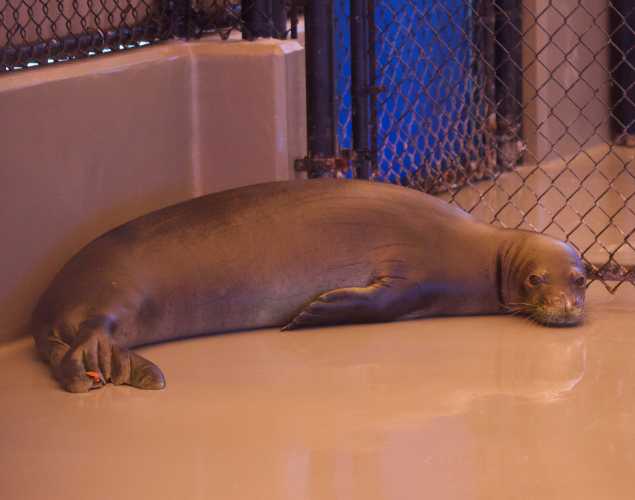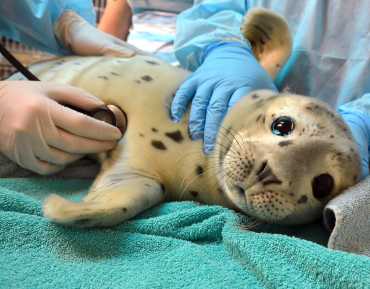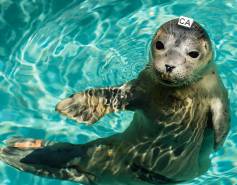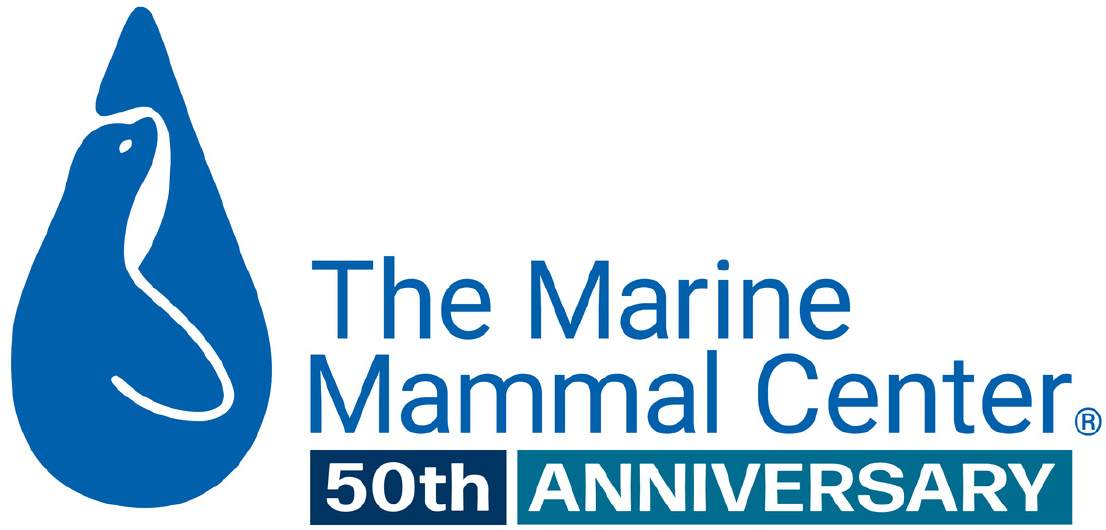
Endangered Hawaiian Monk Seal RH38 Receiving Life-Saving Care at The Marine Mammal Center
Endangered Hawaiian Monk Seal RH38 Receiving Life-Saving Care at The Marine Mammal Center
The Marine Mammal Center, the world’s largest marine mammal hospital, has admitted an endangered Hawaiian monk seal at the Center’s hospital in Kailua-Kona, Ke Kai Ola. The adult female monk seal, RH38, is currently in stable condition. The successful rescue of RH38 from Kaua'i was made possible thanks to support from the community and the Center’s partnership with the National Oceanic and Atmospheric Administration (NOAA) and the U.S. Coast Guard (USCG).
“Before the rescue, RH38 was monitored for over a week. She displayed intermittent logging behavior in shallow water, meaning she was floating instead of actively swimming, and appeared weak, raising questions about her overall energy levels and strength,” says Dr. Sophie Whoriskey, Hawaiian Monk Seal Conservation Veterinarian at The Marine Mammal Center. “Given this seal’s prior history, including being treated for kidney stones, the decision was made to rescue RH38 for further evaluation.”
Given this seal’s prior history, including being treated for kidney stones, the decision was made to rescue RH38 for further evaluation.
During the seal’s initial critical care period which included an admission exam, the Center’s veterinary team noted that RH38 was alert, reactive, and in good body condition. Experts collected blood, urine, and did a brief ultrasound of the kidneys and bladder during the initial exam that revealed abnormalities in the kidneys and uterus. The ultrasound also revealed RH38 is suffering from kidney stones and has a fracture of her left upper canine tooth.
The Center’s veterinary team performed additional diagnostics for RH38 including full body radiographs (X-rays) and a more extensive abdominal ultrasound exam. Experts also submitted a series of blood samples for diagnostic testing to check for signs of disease, some of which will take several weeks to process. The team can confirm that the animal’s antibody test for toxoplasmosis was negative.
Animal care experts are offering her a hearty and calorie-rich diet of sustainably caught herring and she has shown a great appetite. RH38 is also receiving antibiotics for suspected pneumonia.
A Timely Response to a Seal in Need
Thanks to members of the public calling NOAA’s statewide marine wildlife hotline (888-256-9840), NOAA was alerted to RH38’s abnormal logging behavior. After monitoring RH38’s behavior over about a week, and carefully weighing the benefits and risks of intervention, NOAA, with input from the Hawaiʻi Department of Land and Natural Resources (DLNR) and the Center, decided that given RH38’s notable behavior change and prior history, medical assessment, and treatment were in her best interest. A successful response was conducted on June 24, and the USCG transported her to the Center the next day.
“Sometimes seals don’t clearly show signs that they’re sick or healthy. It’s our job to carefully assess each individual seal, consider what’s normal behavior and body condition for that seal, compare that to their past medical history, and what care we might be able to provide them, to make the best decision possible for each seal,” said Diana Kramer, Regional Stranding Coordinator for NOAA’s Pacific Islands Regional Office. “We are grateful to those who called our hotline to report RH38’s abnormal behavior, and our partners at DLNR and the Center for a collaborative effort to help assess, rescue, and provide care for RH38.”
RH38 was born in 2016 and was first admitted to Ke Kai Ola in 2017 for malnutrition and gastrointestinal parasites. She was released in good health and came back in 2019 with a several health concerns including severe traumatic myositis (muscle inflammation) that was diagnosed on CT scan, septicemic infection, kidney stones in both kidneys, urinary tract infection, and presumed pneumonia.
Since 2014, the Center has rehabilitated and released 42 monk seals, most of which have been rescued from and returned to the Papahānaumokuākea Marine National Monument as part of the Center’s partnership with NOAA Fisheries. Together, the Center works with NOAA to identify seals in need, rescue and rehabilitate them, and give them a second chance at life.
The Center’s partnership with NOAA Fisheries and other cooperating agencies is more important than ever to prevent this endangered species from becoming extinct.
You Can Help
The Marine Mammal Center is recruiting new volunteers for operations on Maui.
Hawaiian monk seal conservation volunteers play an integral role in helping save this endangered species by monitoring and identifying seals that may require rescue and rehabilitation. Volunteers also provide valuable public outreach to help raise awareness about the risks of human and pet interactions, and why this native animal is critical to the health of our shared ocean home.
The Center values volunteer engagement and inclusivity, and is proud to welcome existing and new volunteers into its ‘ohana, or family, to create an even more robust and diverse community of volunteers.
Since 2014, the Center has rehabilitated and released 42 monk seals, most of which have been rescued from and returned to the Papahānaumokuākea Marine National Monument as part of the Center’s partnership with NOAA Fisheries. Together, the Center works with NOAA to identify seals in need, rescue and rehabilitate them, and give them a second chance at life.
The Center’s partnership with NOAA Fisheries and other cooperating agencies is more important than ever to prevent this endangered species from becoming extinct.
For more information or to set up an interview on this topic, please contact us at media@tmmc.org.
Header image: Photo © The Marine Mammal Center, NOAA Permit #24359
Yes, I want to save a life!

Yes, I want to save a life!
You’ll be giving sick and injured animals the best possible care at the Center’s state-of-the-art hospital. With your gift today, you are giving a patient a second chance at life in the wild.
See Our Latest News
{"image":"\/Animals\/Patients\/Harbor seals\/2020\/cropped-images\/hs-barnwood-by-bill-hunnewell-c-the-marine-mammal-center-315-0-3299-2577-1607370547.jpg","alt":"harbor seal Barnwood","title":"Last-Minute Gift Guide \u2013 Top Gifts that Give Back to Marine Animals","link_url":"https:\/\/www.marinemammalcenter.org\/news\/last-minute-gift-guide","label":"News Update","date":"2025-12-18 01:00:00"}

Last-Minute Gift Guide – Top Gifts that Give Back to Marine Animals
December 18, 2025
Read More{"image":"\/Animals\/Patients\/Hawaiian monk seals\/2025\/cropped-images\/b-ru72admission-to-ke-kai-ola112125photo-c-the-marine-mammal-center-noaa-permit-24359-0-364-1270-992-1766095407.jpg","alt":"A newborn Hawaiian monk seal pup with a black coat in rehabilitative care.","title":"Newborn Hawaiian Monk Seal Pup Now Receiving Care","link_url":"https:\/\/www.marinemammalcenter.org\/news\/newborn-hawaiian-monk-seal-pup-now-receiving-care","label":"Patient Update","date":"2025-12-18 01:00:00"}

{"image":"\/Animals\/Patients\/Hawaiian monk seals\/2025\/cropped-images\/d-ru28release-exam-at-ke-kai-ola111025photo-by-giancarlo-rulli-c-the-marine-mammal-center-noaa-permit-24359-0-0-1270-992-1764620886.jpg","alt":"","title":"Bird Flu Vaccine Trial Offers Hope for Protecting Hawaiian Monk Seals","link_url":"https:\/\/www.marinemammalcenter.org\/news\/bird-flu-vaccine-trial-may-offer-hope-for-protecting-hawaiian-monk-seals","label":"News Update","date":"2025-12-01 08:13:00"}

Bird Flu Vaccine Trial Offers Hope for Protecting Hawaiian Monk Seals
December 1, 2025
Read More{"image":"\/Animals\/Patients\/Hawaiian monk seals\/2021\/hms-pp08-by-sheila-latta-c-the-marine-mammal-center-noaa-permit-18786.jpg","alt":"Hawaiian monk seal","title":"The New York Times: Inside the Bird-Flu Vaccine Trial for Monk Seals","link_url":"https:\/\/www.marinemammalcenter.org\/news\/the-new-york-times-inside-the-bird-flu-vaccine-trial-for-monk-seals","label":"In the News","date":"2025-12-01 01:00:00"}

The New York Times: Inside the Bird-Flu Vaccine Trial for Monk Seals
December 1, 2025
Read More